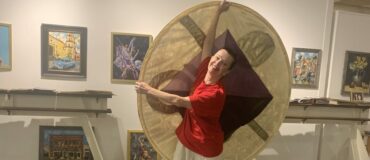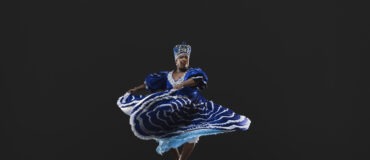By Tere Elizalde
Tere Elizalde is a 2022 Archiving and Preservation Fellow with Guadalupe Cultural Arts Center/Guadalupe Dance Company. Read more about the Fellowships here. This is the first part of Tere’s blog.
July 21, 2022: A Community’s Shared Memory
When I first got notice from Dance/USA that I was selected as the Archiving Fellow to work with the Guadalupe Cultural Arts Center (GCAC) in San Antonio, Texas, I was excited about the opportunity to work with an organization that shared my overall vision of planning for access and sustainability. This summer, I will be working alongside the dance side of the organization to inventory their Dance Company and Dance Academy materials in order to understand what is in the collection. I will also serve as a thought partner, which will involve creating policies and procedures so the GCAC can continue the work done over the summer and help realize their goals of preserving their collection, eventually making it accessible to the broader community within San Antonio, those interested in Mexican, Mexican-American, and Native American dance, and beyond.

Folklorico dancers. Courtesy of Guadalupe Cultural Arts Center.
While Dance/USA planned for the project this summer to be onsite and in-person, the pandemic is not over. For the first week, I had to adjust to working remotely due to COVID cases in the area. Fortunately, prior to working onsite, I was able to have several phone calls with members of the GCAC where I learned a bit more about the organization and project needs. These staff members included Belinda Menchaca and Connie Espinoza, who are the Education Director and Education Assistant, respectively, and Jeannette Chavez, the organization’s Dance Director. These members will be those I will be in most contact with during the summer, providing me with their knowledge of dance and institutional memory. I learned from them that the GCAC is multidisciplinary in its approach to promoting and preserving various performing arts and literature featuring local San Antonio, Tejano, and Chicano artists, and has been a mainstay for over thirty years in San Antonio. The Guadalupe Dance Company and Academy centers on folklorico, flamenco, salsa, and stilts and there are elements of Indigenous and Native American dance as well as contemporary dance. Although simply called folklorico, this form of dance has regional variations, evident in the music and costumes worn by the performers.

Photographs and other ephemera showcasing neighborhood and theater history at the Guadalupe Theater.
Members of the organization also stay involved for a long time. For instance, some staff were once Dance Academy students. As they become older, they apprentice to learn new responsibilities, and then become company members for the Dance Company. They might also become full-time staff members for the organization as a whole. As a result, staff learn how to do many types of jobs and perform many different functions. For this reason, I will need to prioritize creating an archiving plan which requires a feasible amount of time and effort for their busy team
I also learned that despite the Dance Company and Dance Academy’s history and involvement in San Antonio, not everyone in the community is aware of the depth of their activities and the work they do. Thus, not only sharing their dance work, but sharing their community connections and shared history is also an important goal to the organization.

Contents of an AV box consisting of various formats of videotapes in the GCAC collection at UTSA Special Collections.
Prior to working onsite at the GCAC, I also had the opportunity to visit the University of Texas San Antonio (UTSA) and its Special Collections, where my local archivist mentors, Amy Rushing and Barrett Codieck, work. They informed me that years ago, they received a large donation of GCAC materials, which they inventoried but did not yet complete processing. However, processing the collection is one of their goals due to GCAC’s established presence in San Antonio. During my visit, I was able to view the collection and get some advice for the project. Viewing the collection helped prepare me for the types of materials I might encounter, such as AV materials in older formats used in the organization’s early years, and what activities were emphasized in its paper materials such as Tejano Conjunto and CineFestival, long-running festivals of conjunto music and Latino film respectively. While this donation represented the GCAC as a whole rather than just dance materials, it was also helpful to see what material types they collected, which seemed to be everything from newsletters, programs, contracts, and more. Seeing different formats made it clear that there is a possibility I may encounter almost anything.
It was also helpful to view different models for inventorying collections. Since one of our goals is that members of the GCAC are able to continue to inventory as they create new records, I want to ensure that the process considers organizational needs, particularly the type of information to input and how much time it will take to do so. The process UTSA Special Collections used was straightforward for their AV collection, recording information such as title, format, and condition, which would be easy to input and helpful when considering the GCAC’s priorities for their collection such as increasing findability and planning for digitization. While it didn’t consider descriptive information about the people involved or dance elements, I will be working with those who hold this information, and can include it more readily.

Close up of the GCAC’s symbol painted on the side of one of its buildings.
Once I was onsite, I was given a tour of the GCAC campus by Jorge Pina, the Program Director, getting a glimpse of the different buildings owned by the organization within the community. I learned more about the influences of history and culture on the organization and the Westside neighborhood. Not only are murals a frequent sight on nearby buildings, but those that are a part of the GCAC campus often showcase historical and cultural elements as well. For example, the campus has repurposed and renovated several buildings without erasing or forgetting their origins. Their bookstore was once the neighborhood’s Progreso Drugstore, and a sign can still be seen outside. GCAC’s theater has several exhibits and artworks including photographs showing the early years of the Westside and costumes from an early dance performance. Throughout the campus, both inside and outside, a common detail is the organization’s symbol.
As I became familiarized with my space and some of the history of the GCAC, I learned that the first thing I would need to do was an assessment of the collection before any in-depth inventory work. I have to learn what material formats currently exist, their locations including storage, and their general condition such as damage or labeling. Unlike an institutional archive affiliated with a university, such as the one where I previously worked, or other larger archives, it is very common for performing arts organizations to not have a dedicated system in place for organizing or labeling their records, so records are located throughout the building. Fortunately, however, I will be working with those who have a shared memory of the Dance Company and Dance Academy to fill in the gaps and bring to life what I will find.
All photos courtesy of the author except where noted.
 Tere Elizalde is pursuing a master’s degree in information science at the University of Michigan’s School of Information, focusing on Digital Archives, Library Science, and Preservation. Prior to studying archives, she obtained her MA in International and Regional Studies from the University of Michigan in 2021.
Tere Elizalde is pursuing a master’s degree in information science at the University of Michigan’s School of Information, focusing on Digital Archives, Library Science, and Preservation. Prior to studying archives, she obtained her MA in International and Regional Studies from the University of Michigan in 2021.
Drawn to how history impacts people’s way of interacting and understanding information, she sought out archives as a way to engage with underrepresented communities and increase their visibility and stories in collections to reshape societal narratives about history.
Currently working at the Bentley Historical Library as a Reference Assistant, she gets to experience and understand how various audiences interact with archives, and uses it to inform her archival practice.
Tere is looking forward to bringing her past and current experiences in research, reference, preservation, and community engagement to work alongside the Guadalupe Cultural Arts Center this summer to begin the process of creating a sustainable and community-accessible archive that features the center’s rich and cultural engagement with dance.
____
We accept submissions on topics relevant to the field: advocacy, artistic issues, arts policy, community building, development, employment, engagement, touring, and other topics that deal with the business of dance. We cannot publish criticism, single-company season announcements, and single-company or single artist profiles. Additionally, we welcome feedback on articles. If you have a topic that you would like to see addressed or feedback, please contact communications@danceusa.org.
Disclaimer: Opinions expressed in guest posts do not necessarily represent the viewpoints of Dance/USA.





